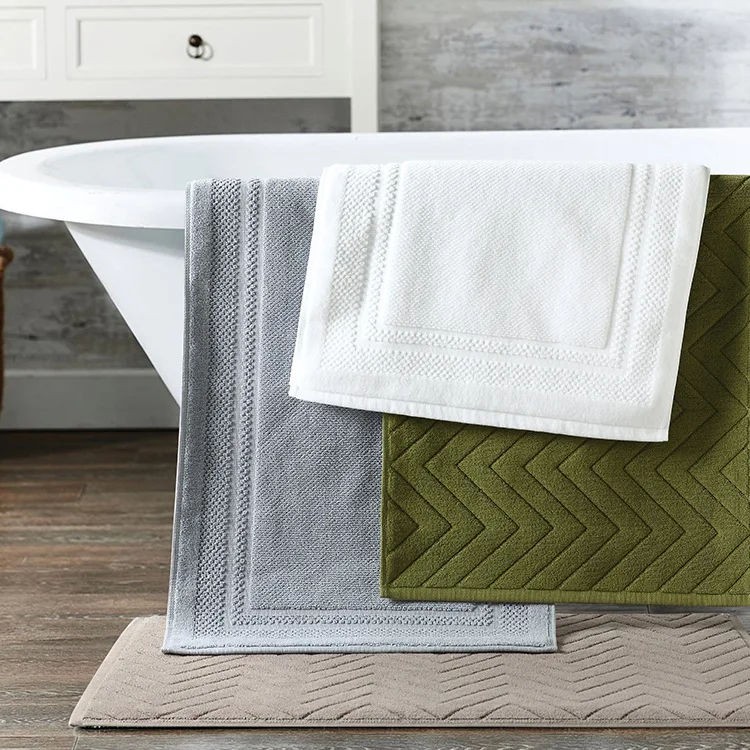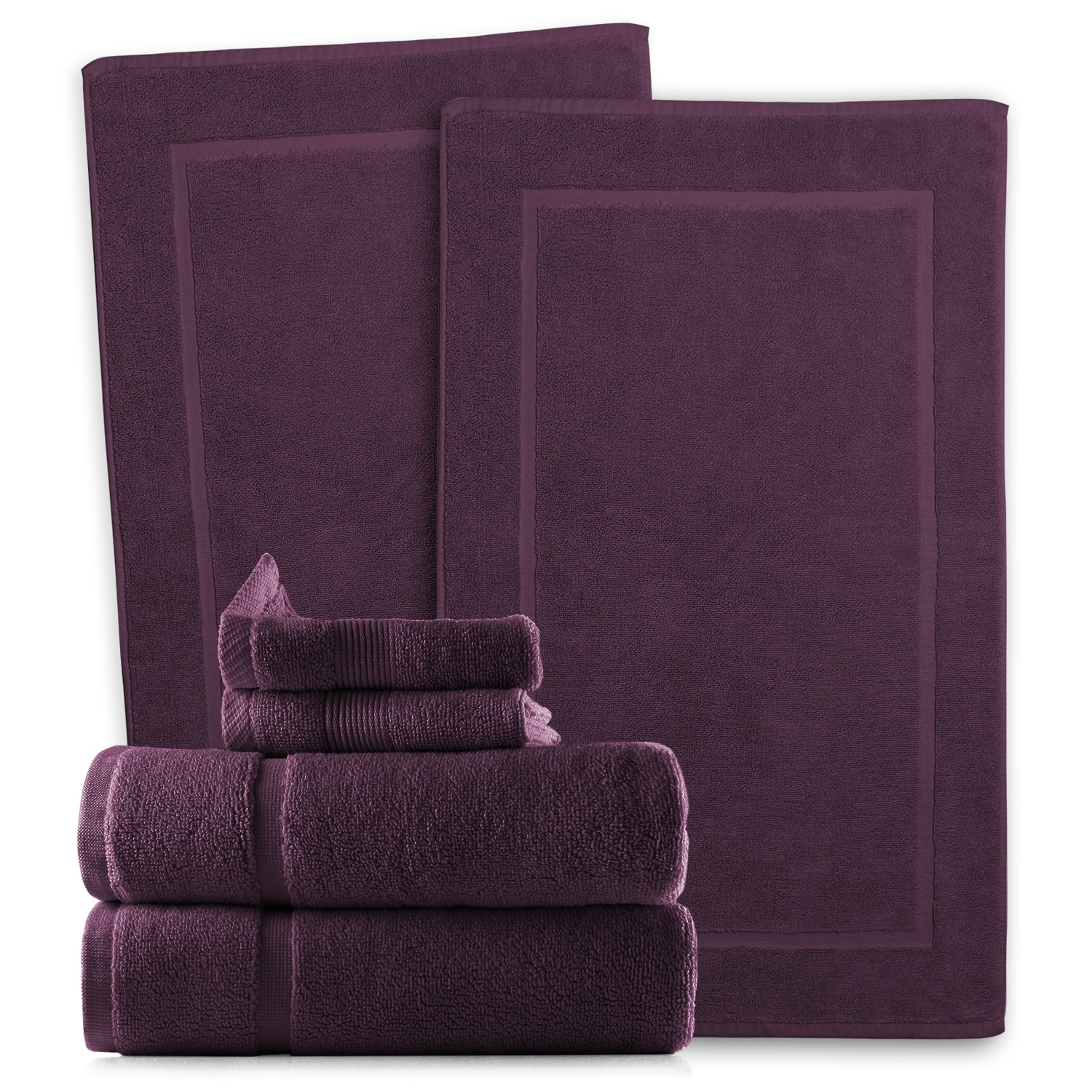Bathroom Towel and Bathmat Materials

Choosing the right materials for your bathroom towels and bathmats is crucial for comfort, absorbency, and durability. The material you choose can significantly impact the feel and functionality of your bathroom textiles. Let’s explore some of the most common materials used for bathroom towels and bathmats and their respective advantages and disadvantages.
Common Bathroom Towel and Bathmat Materials
A variety of materials are used for bathroom towels and bathmats, each with its unique properties. Here is a breakdown of some of the most popular options:
- Cotton: Cotton is a natural fiber that is soft, absorbent, and breathable. It is a popular choice for bathroom towels and bathmats because it is comfortable against the skin and dries quickly. Cotton is also relatively inexpensive and easy to care for. However, cotton can shrink in the wash and may wrinkle easily.
- Microfiber: Microfiber is a synthetic fabric made from polyester or nylon. It is known for its exceptional absorbency, even exceeding cotton in some cases. Microfiber towels and bathmats are also very soft and lightweight, making them a good choice for those who prefer a more luxurious feel. Microfiber is also quick-drying and resistant to mildew and bacteria. However, microfiber can be less durable than cotton and may not be as breathable.
- Bamboo: Bamboo is a natural fiber that is becoming increasingly popular for bathroom textiles. It is known for its softness, absorbency, and antibacterial properties. Bamboo is also eco-friendly and sustainable, as it grows quickly and requires minimal water. However, bamboo can be more expensive than cotton or microfiber, and it may not be as durable.
- Linen: Linen is a natural fiber made from flax plants. It is known for its durability, absorbency, and breathability. Linen towels and bathmats are also naturally antimicrobial and hypoallergenic, making them a good choice for people with sensitive skin. However, linen can be more expensive than cotton and may wrinkle easily.
Material Comparison Table
Here is a table summarizing the characteristics, advantages, and disadvantages of each material:
| Material | Characteristics | Advantages | Disadvantages |
|---|---|---|---|
| Cotton | Soft, absorbent, breathable, relatively inexpensive, easy to care for | Comfortable against the skin, dries quickly, affordable, easy to maintain | Can shrink in the wash, may wrinkle easily |
| Microfiber | Exceptionally absorbent, soft, lightweight, quick-drying, resistant to mildew and bacteria | Highly absorbent, comfortable, dries quickly, hygienic | Less durable than cotton, may not be as breathable |
| Bamboo | Soft, absorbent, antibacterial, eco-friendly, sustainable | Comfortable, hygienic, environmentally friendly | More expensive than cotton or microfiber, may not be as durable |
| Linen | Durable, absorbent, breathable, naturally antimicrobial and hypoallergenic | Long-lasting, comfortable, hygienic, suitable for sensitive skin | More expensive than cotton, may wrinkle easily |
Bathroom Towel and Bathmat Styles and Designs: Bathroom Towels And Bathmats

Choosing the right bathroom towels and bathmats can significantly impact the overall aesthetic of your bathroom. Beyond their practical function, these items serve as decorative elements that reflect your personal style and create a welcoming ambiance.
Bathroom Towel Styles and Designs
Bathroom towels come in various styles and designs, catering to diverse preferences and bathroom themes.
- Size: Bathroom towels are available in various sizes, each serving a specific purpose. Hand towels, typically smaller in size, are ideal for drying hands. Bath towels, larger and more absorbent, are used for drying the entire body.
- Shape: While most towels are rectangular, some come in unique shapes like round or square. These unique shapes add a touch of whimsy and personality to the bathroom.
- Color: From classic white to vibrant hues, bathroom towels offer a wide range of colors. Choosing colors that complement your bathroom decor creates a cohesive and visually appealing space.
- Pattern: Bathroom towels can feature various patterns, from simple stripes and polka dots to intricate floral designs. Patterns can add a touch of personality and sophistication to your bathroom.
Bathroom Bathmat Styles and Designs
Bathmats are essential for providing a safe and comfortable surface to step onto after a shower or bath. They also add a decorative touch to the bathroom floor.
- Material: Bathmats are made from various materials, including cotton, microfiber, bamboo, and rubber. Each material offers unique benefits in terms of absorbency, durability, and comfort.
- Shape: Bathmats are typically rectangular, but some come in unique shapes like oval or round, adding a touch of personality to the bathroom.
- Color: Bathmats are available in a wide range of colors, allowing you to choose colors that complement your bathroom decor.
- Pattern: Bathmats can feature various patterns, from simple geometric designs to intricate floral patterns, adding a touch of personality and sophistication to your bathroom.
Popular Bathroom Towel and Bathmat Design Trends
The design world is constantly evolving, and bathroom towel and bathmat designs are no exception. Here are some popular trends:
- Minimalist: Minimalist bathroom towels and bathmats are characterized by their simple designs and neutral colors, creating a clean and uncluttered look.
- Geometric: Geometric designs, featuring bold shapes and patterns, add a modern and sophisticated touch to the bathroom.
- Floral: Floral patterns, from delicate blossoms to bold tropical prints, add a touch of elegance and femininity to the bathroom.
- Bohemian: Bohemian bathroom towels and bathmats feature earthy tones, intricate patterns, and natural materials, creating a relaxed and bohemian ambiance.
Visual Representation of Bathroom Towel and Bathmat Designs
| Style | Description |
|---|---|
| Minimalist | A white bath towel with a simple border and a beige bathmat with a subtle geometric pattern. |
| Geometric | A bath towel with a bold black and white geometric pattern and a bathmat with a matching design. |
| Floral | A bath towel with a delicate floral pattern in pastel colors and a bathmat with a similar floral motif. |
| Bohemian | A bath towel with a colorful, intricate pattern and a bathmat made from natural fibers with a fringe detail. |
Bathroom Towel and Bathmat Care and Maintenance

Proper care and maintenance are crucial for extending the life of your bathroom towels and bathmats while maintaining their hygiene and absorbency. Following these simple guidelines will ensure that your towels and bathmats remain soft, fluffy, and free from bacteria.
Washing Bathroom Towels and Bathmats
Washing your towels and bathmats regularly is essential for maintaining hygiene and preventing the buildup of bacteria and mildew.
- Wash Towels and Bathmats Separately: Wash towels and bathmats separately from other laundry items to prevent lint transfer and maintain their absorbency. Towels and bathmats are typically made of absorbent materials that can attract lint from other fabrics.
- Use the Right Water Temperature: Use hot water (140°F or 60°C) to effectively kill bacteria and remove dirt. Hot water also helps to remove body oils and other residues that can accumulate on towels and bathmats.
- Choose the Appropriate Detergent: Select a mild detergent specifically designed for towels and bathmats. Harsh detergents can strip towels of their natural oils, leading to dryness and stiffness.
- Avoid Fabric Softener: Fabric softener can reduce the absorbency of towels and bathmats by creating a coating on the fibers.
- Wash Towels and Bathmats Frequently: Wash towels after every 2-3 uses to prevent the buildup of bacteria and mildew. Bathmats should be washed more frequently, especially if they are used by multiple people.
Drying Bathroom Towels and Bathmats
Proper drying is crucial for preventing mildew growth and maintaining the softness and absorbency of your towels and bathmats.
- Tumble Dry on Low Heat: Tumble dry towels and bathmats on low heat to prevent shrinking and damage. High heat can cause towels to become stiff and scratchy.
- Avoid Over-Drying: Over-drying can lead to towels becoming stiff and scratchy. Remove towels and bathmats from the dryer while they are still slightly damp.
- Line Dry: Line drying is an alternative to machine drying that helps to preserve the softness and absorbency of towels and bathmats. Hang towels and bathmats in a well-ventilated area, out of direct sunlight.
- Avoid Ironing: Ironing can damage the fibers of towels and bathmats, making them less absorbent.
Storing Bathroom Towels and Bathmats
Proper storage helps to prevent mildew growth and maintain the freshness of your towels and bathmats.
- Store in a Dry, Well-Ventilated Area: Store towels and bathmats in a dry, well-ventilated area to prevent mildew growth.
- Avoid Folding Towels Tightly: Folding towels tightly can create creases that can trap moisture and lead to mildew growth.
- Hang Towels and Bathmats: Hanging towels and bathmats allows them to air out and prevents them from becoming damp and musty.
Preventing Fading, Shrinking, and Damage
To ensure your bathroom towels and bathmats retain their color, shape, and quality, follow these guidelines:
- Wash Towels and Bathmats in Cold Water: Cold water helps to prevent fading and shrinking.
- Avoid Bleach: Bleach can damage the fibers of towels and bathmats, making them less absorbent and causing them to fade.
- Use a Gentle Detergent: Harsh detergents can strip towels of their natural oils, leading to dryness and stiffness.
- Do Not Overstuff the Washing Machine: Overstuffing the washing machine can prevent towels and bathmats from being properly cleaned and can lead to damage.
Maintaining Softness and Absorbency, Bathroom towels and bathmats
Here are some tips and tricks to keep your bathroom towels and bathmats soft and absorbent:
- Use a Vinegar Rinse: Adding a cup of white vinegar to the rinse cycle can help to soften towels and bathmats and remove detergent residue.
- Add Baking Soda: Adding half a cup of baking soda to the wash cycle can help to brighten towels and bathmats and remove odors.
- Dry Towels and Bathmats Completely: Damp towels and bathmats are more prone to mildew growth and can become stiff and scratchy.
- Avoid Using Fabric Softener: Fabric softener can reduce the absorbency of towels and bathmats by creating a coating on the fibers.
Bathroom towels and bathmats – The soft cotton of a towel, the comforting texture of a bathmat, these are the small comforts that make a bathroom feel like a sanctuary. But even these simple things require a touch of organization, a place for everything. Choosing where to place a hand towel ring, like where to place hand towel ring in bathroom , can make a difference in how you experience the space.
After all, even the most mundane tasks, like drying your hands, become a little more pleasant when done in a well-organized and inviting environment.
The soft, absorbent texture of a bathroom towel, the comforting feel of a plush bathmat underfoot – these are the simple pleasures of a well-appointed bathroom. But to truly elevate the experience, one must consider the hardware, and for that, a trip to Costco is often a wise choice.
Costco bathroom towel bars offer a sturdy and stylish solution, ensuring your towels are always within easy reach and ready to absorb the day’s worries. And with a good towel bar, even the simplest of bathroom towels can become a comforting symbol of everyday ritual.